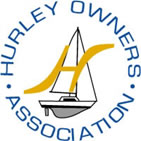


MAST COMPRESSION
The Hurley 22 and 24/70 yachts tend to suffer from a condition that we call mast compression; that is when the coachroof around the mast is deformed downwards by the weight of the mast and the tension of the shrouds. Other yachts in the Hurley range are less affected, as the smaller yachts have more strength, because the structure is more compact. The larger yachts have kingposts from underneath the mast deck plate to the keel plate.s
Some other makes have keel-stepped masts, i.e. mast runs through deck down to keel, e.g. Carter 33, Elizabethan 30. These vessels sometimes have leaks due to faulty mast gaiter glands.
The mast compression problem manifests itself in several symptoms. Firstly, the thin main bulkheads roughly under the mast area might become bent under the load. The coachroof and deck might be deformed out of shape and could even crack in extreme cases. The standing rigging will be difficult to keep in tension and the forestay might become loose and bend when the wind blows. On the 24/70, the timber mast support beams that are on the top of the bulkheads to spread loads might crack in the middle.
The obvious solution would be to put a timber, aluminium or stainless steel post (kingpost) that is attached to the wooden plate on the inside of the coachroof under the mast deck plate. The post should then run down through the cabin sole moulding to a wooden plate that could be glassed onto the encapsulated keel top or the centre of the bilge, if the vessel is a bilge keeler. The solution is the most effective one but is only suitable for boats just used for racing or short-handed, as a lot of interior space will be wasted. It is cosmetically unattractive and will prevent easy access to the forecabin berths, or, in the case of the 22, reduce its size.
The next solution would be to beef up the bulkhead with timber posts running up to the deck support beam or fabricate an articulated post out of stainless steel that performs the same function as a kingpost but is made in such a way as to run up the side of the heads compartment.
If any post is to be fitted, the mast should firstly be unstepped and the deck plate will need to be raised by fitting a carjack between it and the keel to slowly and carefully return the coachroof to its original shape.
Whatever solution you choose is up to personal opinion, depending on how much place you require to retain and cosmetic considerations. Some examples of members' solutions are shown here. My solution to the problem on "Omega" (my Hurley 24) was to fit a mahogany post, routed to fit around the modified bulkhead and bolted to the forecabin furniture moulding and to the transverse mast support beam. My solution was, of course, a compromise, as I wanted to retain forecabin space and access to the heads compartment, but it has worked. I fitted it in 1992 and no movement has been subsequently noted (it is now 2006).
The post was tricky to make. You will need to make a 3D template out of card and have access to a good quality band saw to reproduce the complex angles and mitres. You will also need to estimate the deflection of the coachroof when it is returned to its original position. In my case, it was only 10 mm. My brother was a retained fire fighter at the time and borrowed a hydraulic jack to slowly return the coachroof to its original state. This job was done over several days with the mast down. Much creaking was noted. I cut away the bulkhead at the top to accommodate the post.
Bryan Mermagen's H22 "Mistral" is fitted with an excellent stainless steel solution and Philip H 24/70 "Chances R" is fitted with an excellent and well-constructed kingpost, also of stainless steel.
Not all H22 and24/70 are affected, as all are not affected by osmosis, mostly down to luck, as there seems to be no logic or pattern. If your coachroof is not distorted, you don't need to worry. If it is, don't worry either, as it has probably been like it for a long time and isn't going anywhere. Nothing major is going to happen overnight. These boats are over-built.
Nick Vass